Content
Published:
This is an archived release.
Musculoskeletal problems
More women than men are treated at hospitals. Diseases of the musculoskeletal system were the diseases women were most often treated for in 2014. A substantial share of younger women are treated for these diseases.
| 2014 | |||
|---|---|---|---|
| Both sexes | Females | Males | |
| 1One person can have received treatment at more than one level of care. Only Norwegian residents are included. Source: NPR | |||
| Patients at general hospital, in total | 1 820 983 | 985 423 | 835 560 |
| In-patients | 575 554 | 321 204 | 254 350 |
| Patients with day cases | 209 612 | 116 935 | 92 677 |
| Out-patients | 1 627 726 | 885 201 | 742 525 |
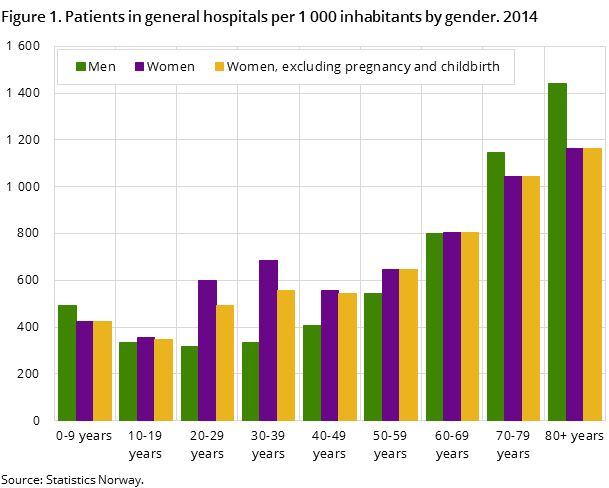
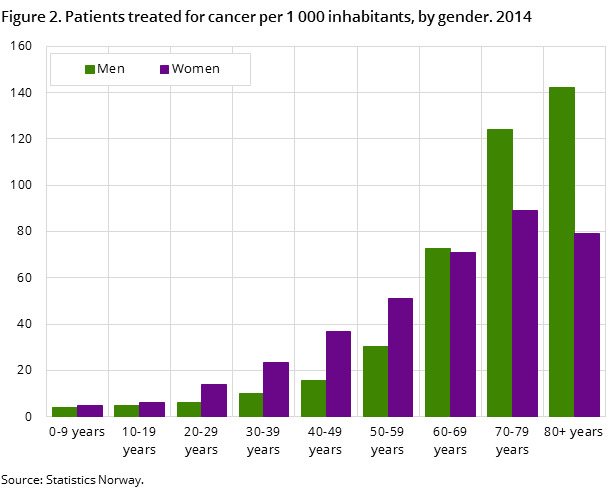
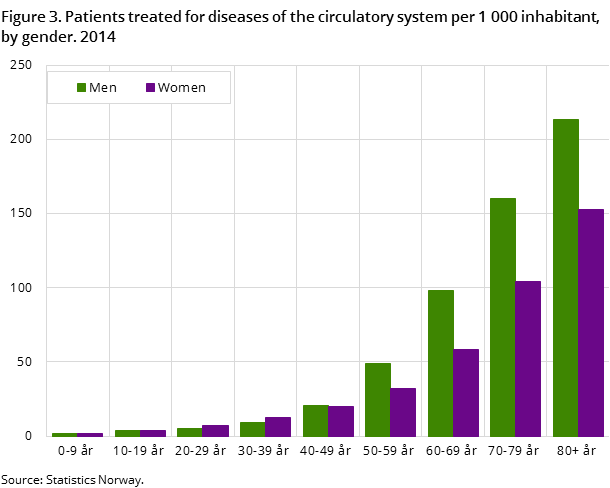
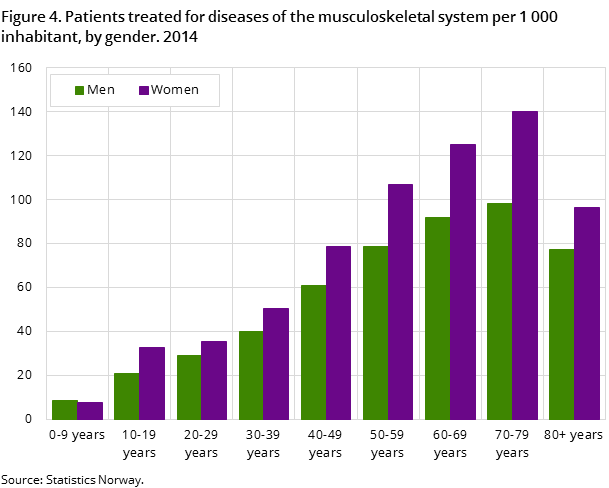
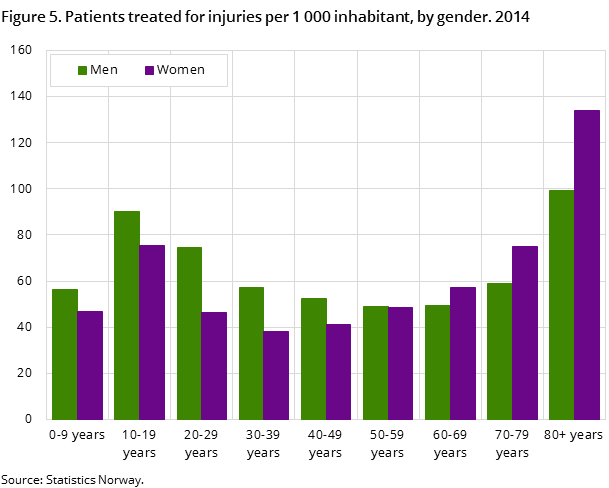
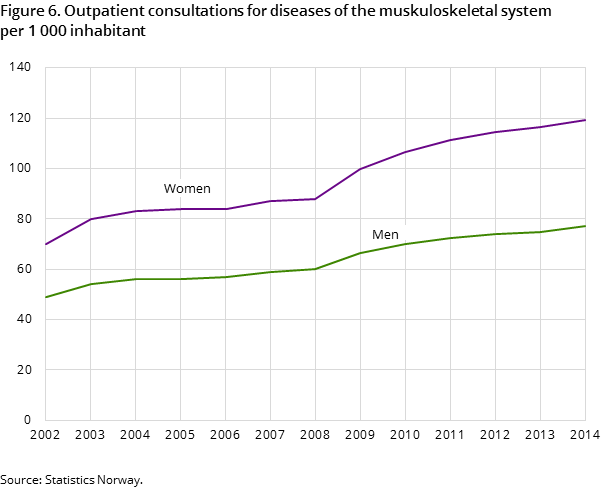
One outpatient consultation per inhabitant
There were 5.3 million outpatient consultations at hospitals in Norway in 2014, i.e. one per inhabitant on average. However, some patients have several treatments while others have none. One in three had an outpatient consultation in 2014.
More treatments were carried out in 2014 during daytime, i.e. without the patient staying overnight, compared to the previous year. There was little change in inpatient treatment (when the patient stays overnight) in 2014 compared to the previous year. For some diseases, there has been a change towards more outpatient treatment, such as diseases of the circulatory system. For cancer and diseases of the musculoskeletal system, all types of treatments (day cases, outpatient and inpatient) have increased.
More women than men are treated in hospital, even when we exclude pregnancy and childbirth. These findings are in line with statistics for primary health care where women more often than men visit their GP.
Diseases of the circulatory system and cancer are two disease groups that a relatively large share of the population is treated for. Compared to these two groups, diseases of the musculoskeletal system are distinguished by the fact that a relatively large share of young people are treated for them. While diseases of the circulatory system and cancer affect relatively few before the age of 40, three to four times as many are treated for diseases of the musculoskeletal system. This is true for all age groups except the two eldest.
The figures show the distribution of patients for four different disease groups by age and gender. Women are more often treated for cancer earlier in life but around the age of 60 there is little gender difference, and after the age of 70 a greater share of men are treated for cancer (see figure 2). At all stages in life more women than men are treated for diseases of the musculoskeletal system (see figure 3), while more men are treated for diseases of the circulatory system (see figure 4). The male population has more injuries early in life, but is surpassed by the female population late in life.
The figures show patients treated for these disease groups per 1000 inhabitants in the respective age groups, for men and women separately. This is important for understanding why men seem to receive far more treatment than women later in life. Fewer men live beyond the age of 70 and 80, compared to women, but a greater share of men who live long lives receive hospital treatment.
Musculoskeletal problems
Diseases of the musculoskeletal system were the type of condition that women were most often treated for in 2014. These diseases were the second most frequent reason for treatment amongst men, after injuries. One in six patients received treatment for a disease of the musculoskeletal system in 2014.
Diseases of the musculoskeletal system comprise a wide range of different diseases associated with pain and varying degrees of disability. Common diseases are rheumatism, arthrosis, back pain, pelvic pain, fibromyalgia and osteoporosis. Osteoporosis particularly concerns elderly women, and can lead to frequent fractures. These fractures are partly recorded as injuries.
During the last ten years, the number of day cases and outpatient consultations per inhabitant has increased. The number of outpatient consultations per 1000 inhabitants increased from 60 to 98 from 2002 to 2014. The increase is partly due to better diagnostic coding over time. The increase for women in this period was from 70 to 119 consultations per 1000 inhabitants. For women, both young and old, the number of treatments has increased. Most patients treated for diseases of the musculoskeletal system receive the treatment as outpatients. There has also been an increase in day cases, from 6 to 10 per 1000 inhabitants over the last ten years, but there is little change in the number of inpatient stays per inhabitant.
Differences from the Norwegian Patient Register Open and readClose
The patient statistics from Statistics Norway are based on data from the Norwegian Directorate of Health’s Norwegian Patient Register (NPR). The population for the patient statistics in Statistics Norway covers the activity in general hospitals according to the definition in the Register of Business Enterprises. This definition deviates somewhat from the population that the NPR uses in its statistics, which covers all institutions with activity-based financing.
Patients living abroad are not includedOpen and readClose
Patients treated in Norway, but living abroad, are not included in the statistics. There were 10 611 foreign patients who received care in 2014. They had 5 020 hospital stays, 413 day cases and 8 849 outpatient consultations.
Contact
-
Geir Hjemås
E-mail: geir.hjemas@ssb.no
tel.: (+47) 93 08 27 75
-
Elin Skretting Lunde
E-mail: elin.skretting.lunde@ssb.no
tel.: (+47) 92 42 70 07
